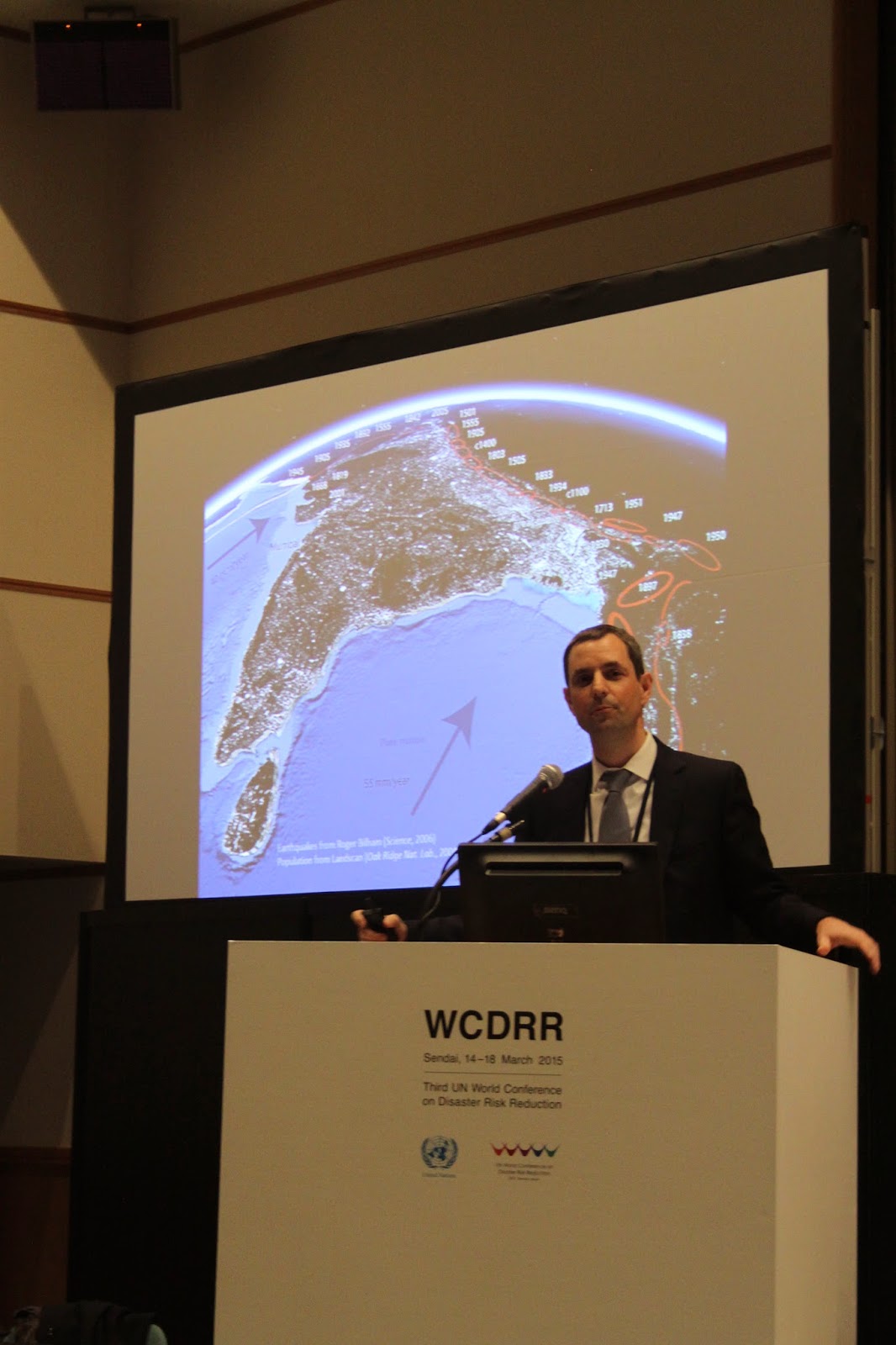World Conference on Disaster Risk Reduction in Sendai - day 1
Arriving in Sendai today, I only had time to visit two sessions after registration.The first session was held in the main conference building and concerned the Hyogo Framework for Action priority 2 where ICHARM member Sawano-san was a panel member; the second was a symposium held across town in the AEX tower where GRIPS students presented their finding. Below are the lessons learned from these sessions.
Outside the Sendai International Conference building:
Inside the main conference building:
Risk Identification and Assessment (Priority
2)
|
||
Schedule
|
2015-03-14
|
15:00-16:30
|
Venue
|
Sendai International Centre,
Hagi Hall
|
|
Organizer
|
UNISDR, UNESCO, GFDRR,
Gov of Japan (MLIT, ICHARM), Gov of New Zealand (MFAT, GNS), with advice from
UNISDR STAG, RMS, IIHS, and NSET, Miyamoto International
|
|
Number
of participants
|
500
|
|
Moderator,
Panelist,
Speaker, etc.
|
Chair: Dr.
Florika Fink-Hooijer, Director of policy, strategy and international, EC ECHO
Moderator: Mr.
Francis Ghesquiere, Manager, Global Facility for Disaster Reduction and
Recovery (GFDRR), The World Bank
Panelists:
Ms. Lianne Dalziel, the Mayor of Christchurch, New Zealand
Dr. Juma Al’Maskari, Director General of Meteorology, Public Authority
for Civil Aviation, Oman
Mr. Muwembe Khalid, Principal Meteorologist, Uganda Meteorology
Department under Ministry of Water, Lands, and Environment, Uganda
Mr. Hisaya Sawano , Chief Researcher of International Centre for Water
Hazard and Risk Management (ICHARM), PWRI, Japan
Dr. Louis Gritzo, VP of research at FM Global, USA
|
|
Objective
|
The Working Session on Risk
Identification and Assessment at WCDRR will draw on the successful risk
identification cases presented on the panel to discuss the challenges and
opportunities for national and international technical and governmental
organizations to ensure future risk information is useful and used.
|
|
Contents
|
Francis Ghesquiere explained the difference between impact (1 hazard event) and risk (all hazards
modeled together).
Florika Fink-Hooijer: Until recently, risk identification only focused on
engineering/modelling, not policy making. EU now has risk identification in
plans and funding, such as the 2010 risk assessment guideline. Your
neighbours will know your vulnerabilities; therefore it is not mandatory to
share data that poses security issues. Risk assessment is required to be
performed every 3 years for Member States to be eligible for DRM funds.
INFORM risk assessment is a collaboration between the Joint Research Centre,
WFP, and the World Bank with open source data. We encourage global usage to
instil trust and ensure comparable data. Remaining problems are that we often
don’t act on information. Political leaders don’t see risk fitting into their
plans.
Lianne Dalziel: 11,000 aftershocks after the Christchurch (New Zealand)
earthquake, 50 were over magnitude 5, 10% GDP loss (twice the GDP of GEJET),
0.5m land subsidence, over 100,000 houses damaged. Post quake there were
cross agency collaborations, data openly available. Science needs to be
relevant and accessible to everyone. Communicating risks is the most
difficult; we need to provide a trusted face to the public.
Hisaya Sawano: In 1961 the Japanese government started collecting flood
damage data which is open to the public. We need to provide tangible
explanations to local people in developing countries, i.e. what happens in
their daily life during floods. How can we connect the role of disaster
information collection agencies and disaster preparedness agencies?
Louis Gritzo: People say the world is a riskier place; I would say the
risk is more global. The development of new data is not the most important.
The most important is how to communicate it to people on the ground and make
sure they use it in time to prepare/respond. Insurance alone is not enough;
you cannot replace people, company reputations, etc. Not just clarify risks,
also make solutions. Don’t talk science to people. Risk is not ‘ if’ but
‘when’ the hazard occurs.
Gavin (UK) replacing Muwembe Khalid: The UK has a voluntary observation
system with WMO, applied in Uganda. Fishers are receiving colored warnings on their phones to not go out during storms. Local people need
to understand the decision makers, e.g. communicate with women who
plant/harvest rather than the local village chiefs who remain unexposed.
|
|
Disaster Management Policies – Preparedness
against Large Tsunamis and Earthquakes etc.
|
||
Schedule
|
2015-03-14
|
18:00-20:00* (*Session started from 13:00)
|
Venue
|
Sendai
City AER TKP Garden City Sendai, Hall D (30th floor)
|
|
Organizer
|
GRIPS
|
|
Number of participants
|
50
|
|
Moderator,
Panelist, Speaker, etc.
|
Moderator: Michael C. Huang, Dr. student, GRIPS
1.
Japanese Master Students of GRIPS
Yuya Kimura, Niigata City Govt. A Study on
Resident Response to Evacuation Information in Areas without Prior Incidents
of Sediment-related Disaster: The Case of Niigata City
2. Disater
Management Policy (DMP) Program (Master Students/ BRI, PWRI) 18:50~19:25
Group 1B Mohd Faiz Syed 2005 India/Mumbai Flood
Group 2B George Chilli Otieno 2010 Indonesia
Mentawai Tsunami
Group 3B Jorge Andres Gonzalez Rojas 2010 Columbia
Flood
3. Diaster
Management (DM) Program (Doctorate Students/ ICHARM of PWRI) 19:25~19:45
Nasif Ahsan How do people decide to evacuate or not? A case
report from the cyclone Aila
Robin Kumar Biswas Prediction tool to break the vicious cycle of
disasters- case of river bank erosion in Bangladesh
|
|
Objective
|
The Japanese
National Graduate Institute for Policy Studies (GRIPS) and UNESCO held an
international symposium on effective disaster management policies against
tsunamis, earthquakes etc. based on the research results of GRIPS’ professors
and students and lessons learnt from the 2011 Great East Japan
Earthquake/Tsunami and other huge disasters. In addition this event provides
an opportunity to exchange views of Japanese and international students of
GRIPS.
|
|
Contents
|
Yuya Kimura: Reasons for people not to
evacuate: no previous experience with disaster, or people thought it would be
okay to stay
Mohd Faiz Syed: Most people died from a stampede due to a tsunami rumor
George Chilli Otieno: communities owned search and rescue resources
which led to few victims
|
|































No comments:
Post a Comment